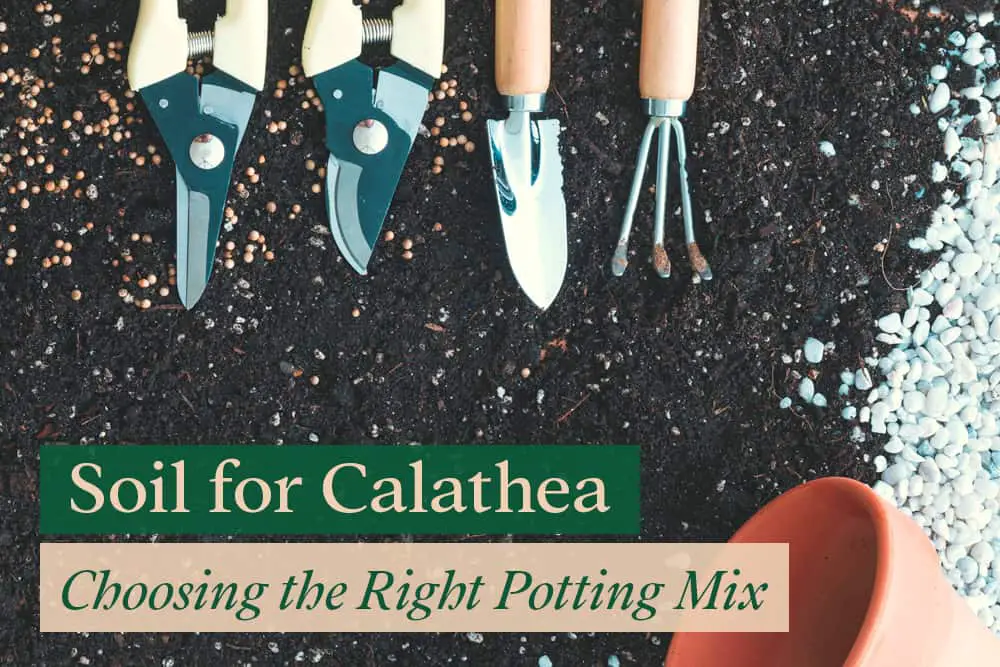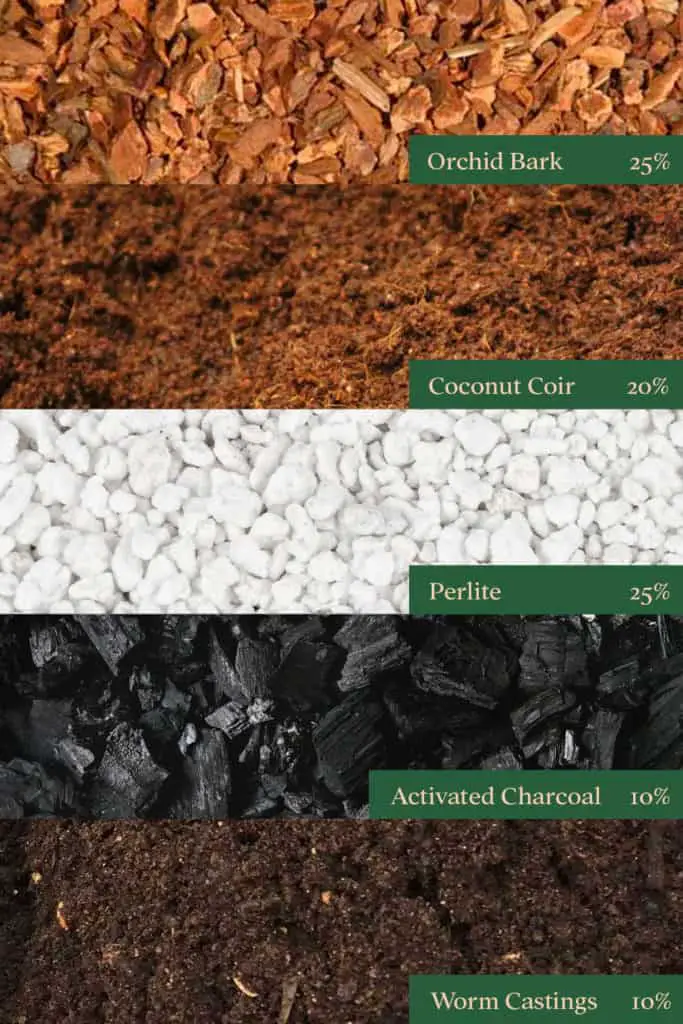
Do you think your Calathea might be unhappy with its soil? Choosing the right type of soil mix is important for your plant to thrive.
Calathea thrives in well-draining, aerated soil with a pH of 6.5. The soil mix also require to have appropriate water retention and nutrient needs for it to grow to their full potential.
This article will also cover the signs of when you need to change your soil as well as how to make your own potting mix.
- Signs You are Using the Wrong Soil Mix
- Calathea Soil Mix Requirements
- How to Mix Potting Soil for Calathea (+materials needed)
- My Recommendation for Ready-made Potting Soil
- Other Factors which May Affect Ingredient Choice in Your Soil Mix
Let’s get started!
Signs You’re Using the Wrong Soil Mix for Calathea
If you suspect that your potting soil has caused your Calathea to become unhappy, these are common signs you can look out for:
1. Soil not drying out
Depending on the time of the year, a few days should be enough to dry the soil out. If it doesn’t dry within a week, you should suspect drainage problems which can be either too little drainage or soil that is starting to compact.
2. Soil is dense and compact
If poking your finger into the top few inches of soil and ground is difficult, then it’s likely too hard or tightly compacted. This can lead to overwatered Calathea plants over time.
3. Leaves curling and discoloration
Once a plant has been left in waterlogged soil for too long, the roots can start to rot and give off reduced nutrient and water access to the leaves. This will cause discoloration and curling of leaves due to excessive transpiration.
4. Calathea not growing or wilt
When the majority of Calathea leaves start to curl and discolor, they must be immediately repotted into the new soil. If left unchecked, the plant’s roots will rot off completely and it will wilt.
5. Soil smell bad
Poorly drained soil can lead to anaerobic decomposition, which results in rotten odor and the release of gases such as ammonia and hydrogen sulfide. If your soil starts to smell very bad, it should be changed ASAP.
So far we’ve discussed the signs that your soil may not suitable for your Calathea, but have yet to cover how to choose the right soil for the prayer plants.
What to Consider When Choosing the Best Soil for Calathea
Like most indoor houseplants, Calathea appreciates soil that is well-draining, slightly acidic, and rich in nutrients.
Most general-purpose potting soil available at your local nursery will work for a Calathea. However, when choosing the best soil for your Calathea, you should make sure it has these qualities:
Aeration
Aeration ensures that the potting soil is not too compact because it has small, porous holes which allow water and nutrients to pass through it into the roots of plants.
Poorly aerated soils deprive the plant of oxygen and contain excess carbon dioxide, slowing down the photosynthesis process and ultimately slow growth.
You can improve aeration by mixing coarse materials – such as shredded bark, perlite, or even fine gravel – into the potting soil to create air spaces.
Well Draining
Well-drained soil allows water to pass through it at a moderate rate and avoid pooling.
When soil does not drain properly, the roots will be susceptible to diseases caused by bacteria. This can lead to root rot, lowering the oxygen and nutrient intake, eventually killing the plant.
The easiest way to loosen compact soil and prevent it from clumping is by introducing organic materials such as compost, mulch, perlite, or vermiculite.
Moisture Retention
Moisture retention refers to the soil’s ability to store enough water and remain moist and damp even after the water has been drained from it.
This will ensure that your Calathea has sufficient water for leaf transpiration as well as providing additional pathways for oxygen to circulate, which improves plant growth.
I often place organic mulch, such as chipped bark, dried pine needles, or shredded leaves, on my potting mix to improve the soil’s moisture retention.
Also read: When and how to water a Calathea plant?
pH Level
Calathea plants need potting soil that has a slightly acidic pH level of 6.5 to thrive.
Extreme acidity in the soil can cause many problems, for instance, a nutrient deficiency or an unfavorable environment for the useful bacteria and soil organisms that work in the soil.
To make the pH higher (less acidic), try adding a form of lime, such as finely ground agricultural limestone.
If your potting soil is too acidic, you can use finely ground agricultural limestone to increase the pH. Alternatively, if the soil pH is too high already, then use peat moss and pine needles to maintain lower pH.
Nutrients Content
High-quality potting soil will have higher levels of nitrogen (N), phosphorus (P), potassium (K), and micronutrients than a standard potting mix.
These nutrients are needed to enable plants to thrive, fight diseases and will help your Calathea grow more quickly.
The most organic way to add nutrients to the soil is to layer compost or plant residues on the surface of the soil, which will be broken down by bacteria and microbes into nutrients.
Alternatively, you can feed your Calathea with fertilizer during watering.
Recipe for Making DIY Soil for Calathea
Here is my soil mix recipe that I’ve used on all of my houseplants, including Calatheas:

Orchid Bark (25%)
Bark chips are the shredded or chipped pieces of tree bark that can be put directly into your soil. They help provide plants with extra nutrients, and their coarse nature allows them to aerate the soil while resisting compaction and providing drainage.
Coconut Coir (25%)
This organic material extracted from coconuts is perfect for both draining water and retaining moisture in the soil. It has the capability to absorb 10 times its weight of water.
Perlite (25%)
Perlites are small porous rocks that help modify the soil substructure to be less compact and better draining, leading to aerated and well-drained potting mix.
Worm Castings (10%)
Worm casting supercharges your soil, providing your plant with the rich nutrients it needs to grow. It also regulates the pH of the soil at a suitable level on average between 6 and 7.
Activated Charcoal (5%)
Activated charcoal is highly porous charcoal that has been processed using gas, high temperature, or chemicals. It can help your soil repel insects and prevent mold while also absorbing excess water.
Alternative if you can’t find all the ingredients
Although easy to find in the US, that may not be the case overseas. If you are unable to find some of these ingredients abroad, use 30% to 50% perlite or gravel and just mix it with your store-bought potting soil.
Mixing the Ingredients
I like using large plastic containers or buckets as my mixing bowl for potting soil because I can make a large batch and store it for repotting other plants later.
There is no fancy step-by-step process needed to mix soil for Calathea, just add all of the ingredients in the proportions mentioned above and stir it with a gardening spoon or your hand!
Best Ready to Buy Soil for Calathea
I enjoy making my own soil because I can control what goes inside it. However, as a beginner plant parent, I used to buy FoxFarm Ocean Forest for all of my houseplants.
Frankly, it was terrific and I make all my plants happy!
It was a really nicely aerated and well-draining soil which also retain water quite well. The pH level is also adjusted at 6.3 to 6.8 so that the plant can absorb fertilizers more efficiently.
My main concern is the price. I could make my own potting soil for half the price. However, the convenience and hassle factor can’t be underestimated – that is the issue of convenience vs cost
Factors Which May Affect Your Ingredients Choice in Soil Mix
Temperature & Humidity
In warmer climates, the rate of photosynthesis and transpiration is higher and your soil mix must be able to retain more water. I suggest adding a layer of sphagnum mosses as a top dressing to avoid excessive moisture evaporation.
If you live in a colder climate and it experiences temperatures below 50°F, make sure the soil is properly aerated and well-drained to avoid overwatering. You may need to adjust your perlite and bark ratio range of 30% to 35% while reducing the amount of coconut coir used.
Watering Habits
If you tend to overwater your plants, you could try mixing soils that are less retaining moisture and more aerated by incorporating more perlite.
A little bit of activated charcoal is also good for absorbing excess water and killing off bacteria may cause root rot.
In conclusion
When it comes to Calathea, the soil is an important factor. The soil must have proper aeration, moisture retention, and well-draining capabilities. Additionally, the right pH level and nutrition content will help your Calathea thrives.
Never feel obligated to make your own potting mix. Though it can be tempting, unless you have the time and means to obtain each of the materials, there is no need for you to do so. Quality soil mixes are available at local nurseries as well as online shops making this task an easy one.
